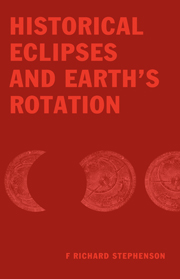Book contents
- Frontmatter
- Contents
- Principal Symbols
- 1 Variations in the length of the day: a historical perspective
- 2 Tidal friction and the ephemerides of the Sun and Moon
- 3 Pre-telescopic eclipse observations and their analysis
- 4 Babylonian and Assyrian records of eclipses
- 5 Investigation of Babylonian observations of solar eclipses
- 6 Timed Babylonian lunar eclipses
- 7 Untimed Babylonian observations of lunar eclipses: horizon phenomena
- 8 Chinese and other East Asian observations of large solar eclipses
- 9 Other East Asian observations of solar and lunar eclipses
- 10 Records of eclipses in ancient European history
- 11 Eclipse records from medieval Europe
- 12 Solar and lunar eclipses recorded in medieval Arab chronicles
- 13 Observations of eclipses by medieval Arab astronomers
- 14 Determination of changes in the length of the day
- Appendix A Timed data
- Appendix B Untimed data
- References
- Acknowledgements
- Index of eclipse records
- Index of places of observation
- Name Index
- Subject index
12 - Solar and lunar eclipses recorded in medieval Arab chronicles
Published online by Cambridge University Press: 13 November 2009
- Frontmatter
- Contents
- Principal Symbols
- 1 Variations in the length of the day: a historical perspective
- 2 Tidal friction and the ephemerides of the Sun and Moon
- 3 Pre-telescopic eclipse observations and their analysis
- 4 Babylonian and Assyrian records of eclipses
- 5 Investigation of Babylonian observations of solar eclipses
- 6 Timed Babylonian lunar eclipses
- 7 Untimed Babylonian observations of lunar eclipses: horizon phenomena
- 8 Chinese and other East Asian observations of large solar eclipses
- 9 Other East Asian observations of solar and lunar eclipses
- 10 Records of eclipses in ancient European history
- 11 Eclipse records from medieval Europe
- 12 Solar and lunar eclipses recorded in medieval Arab chronicles
- 13 Observations of eclipses by medieval Arab astronomers
- 14 Determination of changes in the length of the day
- Appendix A Timed data
- Appendix B Untimed data
- References
- Acknowledgements
- Index of eclipse records
- Index of places of observation
- Name Index
- Subject index
Summary
Introduction
Arab observations of solar and lunar eclipses which are of value in the study of the Earth's past rotation originate exclusively from the medieval period. These records are found in two main sources: (i) chronicles, and (ii) compendia on astronomy. As might be expected, the observations reported in chronicles are essentially qualitative; measurements of any kind are fairly rare. Eclipses and other celestial phenomena (such as bright comets and meteor showers) were mainly noted on account of their spectacular nature. Yet chronicles contain some important astronomical records. The present chapter will be devoted to eclipses described in these works. Arab compendia on astronomy contain many careful measurements of the times of the various phases for both solar and lunar eclipses. These observations will be discussed in chapter 13.
The Arabic names for the Moon and Sun are respectively al-Qamar and al-Shams. In general, medieval Arab chronicles use the term khusuf al-Qamar for an eclipse of the Moon and kusuf al-Shams for an eclipse of the Sun. These designations are still in use today, both among astronomers and the general public. However, medieval Muslim astronomers mostly used kusuf for both types of eclipse, adding the appropriate term for the Moon or Sun. The word khusuf means ‘sinking’, but in describing a lunar eclipse it came to mean a failing of the Moon's light. By contrast, kusuf means a ‘cut’ – i.e. in the solar (or lunar) limb.
- Type
- Chapter
- Information
- Historical Eclipses and Earth's Rotation , pp. 431 - 455Publisher: Cambridge University PressPrint publication year: 1997



